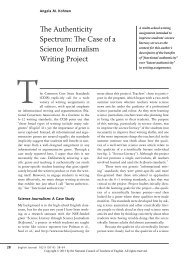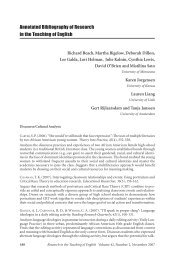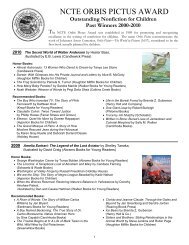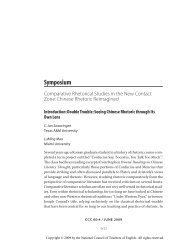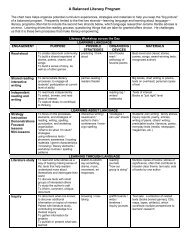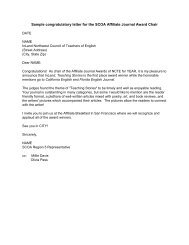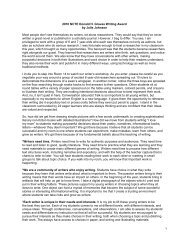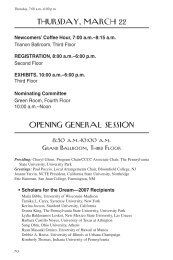1 Float Like a Plane, Sting Like a Bomb: The Ethics of US Drone ...
1 Float Like a Plane, Sting Like a Bomb: The Ethics of US Drone ...
1 Float Like a Plane, Sting Like a Bomb: The Ethics of US Drone ...
Create successful ePaper yourself
Turn your PDF publications into a flip-book with our unique Google optimized e-Paper software.
<strong>Float</strong> <strong>Like</strong> a <strong>Plane</strong>, <strong>Sting</strong> <strong>Like</strong> a <strong>Bomb</strong>: <strong>The</strong> <strong>Ethics</strong> <strong>of</strong> <strong>US</strong> <strong>Drone</strong> Attacksby Evin Hughes1
<strong>Ethics</strong> for Muhammad Ali was like a third arm, a manifestation donned in ashinning scarlet boxing glove that packed a punch hard enough to force his globalaudience to examine the issues <strong>of</strong> racism and war. Ali stringed up his third glove anddanced every time he opined the structural inequalities <strong>of</strong> racism in America or spoke outabout how the recruitment for wars like Vietnam and, most recently, the “war on terror,”was disproportionately towards minorities and the poor. He fought with his ethics-arm inrings shaped like college campus auditoriums and talk-show television sets, one tightlyclenched fist striking into existence a paradoxically nonviolent opus. However, Ali’s roleas a social, anti-war activist began before he ever stepped inside a boxing ring.In interviews conducted by Thomas Hauser, who at the time was writing hisdefinitive biography <strong>of</strong> Ali that was later published in 1991, Muhammad Ali talked abouthis youth when he still went by his birth name, Cassius Marcellus Clay, Jr. “Mymother…[Odessa Clay]…taught us to love people and treat everybody with kindness.She taught us it was wrong to be prejudiced or hate” (Hauser 14). In a similar interview,patriarch Cassius Clay, Sr. said that he taught his son to “always confront the things youfear, try to be the best at whatever you do” (15). When it comes down to it, Ali’s valuesystem was based on the larger proposition that ethics was something that one shouldhold in high-esteem, that above everything a man’s principles mattered (10). Ali <strong>of</strong>tensaid that he had been blessed with God-given “special resources” and since then he had aresponsibility to use them to do good (18).Studying this list <strong>of</strong> Muhammad Ali’s all-inspiring prolific values, I found myselfjuxtaposing them with that <strong>of</strong> this country’s leaders. For example, I asked myself: ShouldBarack Obama, a man that arguably has “special resources,” not be held to the samestandards? Doesn’t our president have the same responsibility to do the right and ethicalthing? Judging by what transpired at the end <strong>of</strong> his first year as president, if Obama washeld to the same principle <strong>of</strong> doing the right thing as Ali held himself, then you will seethat our president’s values didn’t hold up.On January 19, 2010, Obama and his security <strong>of</strong>ficials attended a weeklycounterterrorism meeting. When presented with images <strong>of</strong> fifteen Yemenis suspected <strong>of</strong>being members <strong>of</strong> Al-Qaeda, Obama “insisted on approving every new name on anexpanding ‘kill list,’ poring over terrorist suspects’ biographies on what one <strong>of</strong>ficial callsthe macabre ‘baseball cards’ <strong>of</strong> an unconventional war.” In other words, he wanted to bethe one that decided who would be targeted and killed by drone attacks, a decision theNew York Times called the “final moral calculation” (Becker and Shane). Perhaps it is tooobvious for me to point out, but the fact that Obama is advocating a list <strong>of</strong> people to killmakes any claim for morality illusory, if not blatantly contradictory. Instead <strong>of</strong>unearthing the obvious problems with a policy that gives the power to take awaysomeone’s life to a single individual, republican senator John McCain <strong>of</strong> Arizona andincumbent attorney general Eric H. Holder, Jr. advocated the prosecution <strong>of</strong> those thathad leaked the existence <strong>of</strong> the so-called “kill list.” On the other hand, most <strong>of</strong> the publicunrest caused by the controversy <strong>of</strong> this list is centered on the fact that “theadministration can target for death people it decides are terrorists…on secret evidencewith no review” (Heuvel).Though the declassified documents released on June 19, 2012 by the CentralIntelligence Agency detailing the assassination <strong>of</strong> former Al-Qaeda founder Osama binLaden do not show any concrete evidence <strong>of</strong> those killed in drone strikes during the time,2
they do elicit pertinent information from the CIA on the evolution <strong>of</strong> drones as weaponsin the “war on terror.” In late May <strong>of</strong> 2000, the CIA in compliance with the NationalSecurity Council and other “supporting agencies” decided to test and operate anunmanned aerial vehicle (or UAV) aptly named the “Predator.” What is left <strong>of</strong> theoriginal top secret document—now pockmarked with blank white boxes <strong>of</strong> verifyingshapes and sizes, hiding what the CIA still claims as classified information from thepublic—concludes that the Predator was built as a surveillance drone and its first missionwas conducted over Afghanistan on September 7, 2000. According to the document, thePredator “UAV had completed 10 missions with varying degrees <strong>of</strong> success” (CIA 61).What began as a drone for monitoring possible threats to the security <strong>of</strong> our nationsoon became a machine <strong>of</strong> obscene violence. In 2001, unnamed counterterrorism <strong>of</strong>ficialsdecided that there was an opportunity in “capitalizing on an Air Force program,” anopportunity to weaponize the Predator drone, an opportunity that was too good to passup. It wasn’t long after this decision that the drone was adapted to carry usable Hellfiremissiles (CIA 62), a weapon that experts describe as a highly explosive “copper-linedchargewarhead powerful enough to burn through the heaviest tank armor in existence”(Harris). This is what we are striking down suspected individuals with, a weapondesigned to pierce the armor <strong>of</strong> tanks.Even when equipped with the Hellfire missiles, drones, according to senior editorGordon Duff at Veterans Today, are primitive machines; machines built “to create war, t<strong>of</strong>oster fear and hate where none had existed before, to maintain a continual state <strong>of</strong> warwhere no questions are asked, no evidence is gathered, no fingers pointed.” <strong>The</strong> marineVietnam veteran, Duff explains that though drones are terribly expensive they arecomprised simply <strong>of</strong> a propeller, a few sensors, and a battery to keep them going (Duff).Many supporters for the war that have hyped about the sophistication <strong>of</strong> the technologyused in these drones ignore the news when the inadequacies <strong>of</strong> certain UAV’s arequestioned. For example, they do not mention in the media—though it was minimallycovered—a type <strong>of</strong> drone known as the Global Hawk was unable to even stay in flightand crashed into a Maryland swamp in June, 2012 (Colgrass).Because <strong>of</strong> media sycophants like war activist John Brennan, a White Housecounterterrorism adviser, many people see the drones as “angels <strong>of</strong> death”—an angelictechnology that metes out justice on the behalf <strong>of</strong> the United States. Calling drones“angels <strong>of</strong> death” asserts the notion that targeted killings is an accepted action from areligious standpoint, but this is a laugh in the face <strong>of</strong> all Abrahamic teachings <strong>of</strong> theGolden Rule or its international equivalent the Principle <strong>of</strong> Universality. ManyAmericans develop a bloated sense <strong>of</strong> patriotism, a media-fed consciousness that hostsbinaries <strong>of</strong> “us,” the citizens <strong>of</strong> the United States, and “them,” a category that all peoples<strong>of</strong> middle-eastern descent gets clumped into. This consciousness nourishes phrases like“there are only enemies, a world <strong>of</strong> them.” <strong>The</strong>y do not see that women and children inthese “enemy” countries are <strong>of</strong>ten the ones subjected to the devastation <strong>of</strong> Hellfiremissiles from drone strikes. As long as there are these “angels <strong>of</strong> death” around, they feelsafe in their beds—as long as the newspapers, the TV interviews with counterterrorists,and press releases from the Pentagon, show us that more Al-Qaeda members have died indrone attacks (Duff). To use a reference from popular culture: the “one ring” from theLord <strong>of</strong> the Rings series is the drone, a simple thing that represents the terror <strong>of</strong> humanwill. Consumers <strong>of</strong> corporate media look at a group <strong>of</strong> middle-eastern people and3
categorize all <strong>of</strong> them as “terrorists”, just as orcs categorize all Halflings as “Hobbits,”even though there are Baggins, Tooks, and Brandybucks just as there are Kurds, Ibadis,and Berbers, while the United States—dark lord Sauron—polices middle-east—“middleearth”—chantingmaniacally, “One drone to rule them all, one drone to find them, onedrone to bring them all and in the darkness kill them!”Though the events on September 11, 2001 were acts <strong>of</strong> terrorism by one specificgroup <strong>of</strong> radicalists, the United States set up Special Operations forces in over sixtycountries and has unleashed drones in at least five (Heuvel). For some <strong>of</strong> these countriesthe United States has been bombing continuously since the start <strong>of</strong> this retaliation-war <strong>of</strong>the “war on terror,” including Pakistan. Based on an analysis <strong>of</strong> <strong>US</strong> drone attacks inPakistan, the New America Foundation has statistics that go as far back as 2004. Thisnonpr<strong>of</strong>it organization reports that there have been over three hundred drone strikes inPakistan in the last eight years and death tolls range from two to three thousand. Hence,the real non-militant fatality rate from 2004 to the present is approximately sixteenpercent (New America Foundation).It is important to note that one <strong>of</strong> the most detrimental effects <strong>of</strong> drone attacks,aside from the deaths <strong>of</strong> civilians, is the extreme long-term anti-American sentiment itcreates in the citizens <strong>of</strong> other countries. Synonymous in meaning with William Blake’saphorism “Prisons are built with stones <strong>of</strong> law, brothels with bricks <strong>of</strong> religion,” whichsuggests that law creates criminals and the need for prisons as religion creates a sexuallysuppressed society and the need for brothels, drone attacks create terrorists. Because <strong>of</strong>drone attacks and the devastation they do to cities, Pakistanis are faced with a refugeecrisis. Impoverished children are forced to attend the free schools that are conducted withradical idealists, like the schools <strong>of</strong> the Deobandi tradition <strong>of</strong> Islam during the soviet-Afghan War, which bred the Afghan Taliban faction and the Sunni extremist militias(Kumar). In an interview with Gordon Duff and the Pakistani politician Imran Khan,Khan stated, “Men who begin with love and hope in their hearts, when the drones come,when they see innocent family members die, from that day forward will be warriors andthose who sent the drones [have] turned men into enemies and simple farmers intojihadists” (Duff). John Brennan stated in an interview that targeted killings by droneattacks “reduce the danger to <strong>US</strong> personnel (Brennan)” but the truth is one dead terroristspawns many more in his place, putting American soldiers in even greater danger.<strong>The</strong> prejudices and hate instilled by drone strikes among Pakistanis and otheraffected peoples and cultures is in marked contrast to Muhammad Ali’s principles that helearned from his mother. In March 2003, Ali’s wife Lonnie—speaking on her husband’sbehalf—expressed concern for the wars in Afghanistan and Iraq. In lieu <strong>of</strong> the rise <strong>of</strong> the“war on terror,” Ali was saddened by the violence that was sweeping the globe and wascompletely opposed to the conflict (Butterworth and Gorsevski 60). This display <strong>of</strong> Alicontinuing to stand up for his nonviolent beliefs, despite his ongoing battle withParkinson’s syndrome since his 1984 diagnosis, is reminiscent <strong>of</strong> the courage he had in1960; after returning from the Olympics as a gold-medalist, Ali was not allowed to stepinside a segregated restaurant, so he threw his Olympic medal into a river (59). In anidentical demonstration <strong>of</strong> courage, many war veterans have recently thrown away theirwar medals from Afghanistan and Iraq to symbolize their discontinued support in the warthat causes so much unnecessary suffering (Harcourt).4
If an argument could be made for Muhammad Ali actually possessing “specialresources” endowed to him by God, they would be his “enduring rhetoric [that] providesa model for analyzing texts and social movements invoking the paradox <strong>of</strong> the violence innonviolent civil disobedience” (Butterworth and Gorsevski 50). But what does this mean,violence in nonviolent civil disobedience? Basically, even though Ali was a boxer, asport and occupation based completely on violence, he worked nonviolently for peace.For example, in April 1967, Ali was drafted to participate in the Vietnam War, aconscription that he denied to comply with. After being taken to the United States ArmedForces Examining and Entrance Station in Houston, Ali stood in a straight line with otherdrafted individuals and his name was called; in a nonviolent resistance, he did not stepforward, a felony under the Universal Military Training and Service Act (Hauser 169).Remarking on his summons, Ali stated, “If I thought goin’ to war would bring freedom,justice and equality to twenty-two million Negroes, they wouldn’t have to draft me, I’djoin tomorrow” (Hietala 138). This type <strong>of</strong> behavior, this exhibition <strong>of</strong> impetuousness anddefiance dissolved many political and cultural norms at the time (Butterworth andGorsevski 54). A recent study <strong>of</strong> the anti-war movement during the Vietnam War givesevidence to Ali’s claim <strong>of</strong> the war being disproportionate in its draft towards minorities,showing that double the amount <strong>of</strong> African Americans were inducted by the draft thanwhites (Ernest and Baldwin 125).What Ali was able to do through his nonviolent rhetoric that is still relevant to thisday was successfully make millions <strong>of</strong> people “bear witness” to the violence andirrationality <strong>of</strong> war. For example, say you are watching the news with a roommate andthe news anchor, within her nicely lit and air conditioned studio, talks in a monotoneabout the deaths <strong>of</strong> civilians in a Pakistani market by a drone strike, and your roommateimmediately changes the channel, not giving the terrible story another thought. Yourroommate doesn’t understand the gravity <strong>of</strong> that devastation any more than the newsanchor does; neither understands the significant socio-economical problems that thedrone strike has caused in that area. How about the man sitting behind the joystick, theNintendo-war-controller, pressing the buttons to release the Hellfire missiles like Mari<strong>of</strong>iring at Bowser? Though the drone operator <strong>of</strong> all people probably knows the extent <strong>of</strong>the devastation he is causing, he refuses to think about it, he hides the truth from himself.<strong>The</strong> drone “pilot,” the unenthusiastic anchor, your roommate—they are all complicit.Shoshana Felman, influential in raising issues connected with Holocaust testimony andwhat is called the “crisis <strong>of</strong> witnessing,” says that those that misunderstand or hide whatthey see are unable to take that information and “translate…[it]…spontaneously andsimultaneously into meaning” (Felman 212). Famous psychologists Sigmund Freud andJacques Lacan described this as disavowal—a defense mechanism in which a personrefuses to recognize the reality <strong>of</strong> a traumatic perception (Evans 44).Through speeches recited on college campuses, Ali urged thousands <strong>of</strong> students tobear witness to the problems <strong>of</strong> integration and segregation, hate, and the Vietnam War.In one such speech, he links the violence in Vietnam caused by the war to the violence inthe states; he stated that he would rather fight what was going on in a legal way. Not bywar in a foreign country, but by nonviolent resistance right here in the United States.“Whatever the punishment, whatever the persecution is for standing up for my beliefs,even if it means facing machine-gun fire that day, I’ll face it…” (Hauser 187). Through5
this speech, Ali led as example to all those students in the crowd, to all those seeing andnot choosing to accept reality, to all those in disavowal.What Felman proposes is a community <strong>of</strong> seeing: a space into which “we canbring into consciousness what is unconscious in us”—like the college auditoriums andclassrooms where Ali conducted his speeches—to analyze and make sense <strong>of</strong> events as acommunity (Amy 67). It is the very nature <strong>of</strong> the violence <strong>of</strong> the “war on terror” that doesnot allow a community <strong>of</strong> seeing. <strong>The</strong> media-attack on these countries by ingratiatingnews anchors take the American people and place them onto a platform where they areunable to reach a community <strong>of</strong> seeing, unable to argue the ethics <strong>of</strong> this war. We aredivided, separated from the truth. Democratic representatives John Conyers, DennisKuncinich and many more, were calling for a truth as a community <strong>of</strong> <strong>of</strong>ficials when theywrote letters to the president demanding for him to publicly release the criteria on whichbe would elect people to be attacked by drones on his infamous kill list (Heuvel)—therehas been no more coverage <strong>of</strong> the letters in the media. Unless we become conscious as acommunity <strong>of</strong> the truth <strong>of</strong> the violence we are creating, unless we bear witness anddevelop a community <strong>of</strong> seeing, we are doomed to be “locked into violences we cannotescape” (Amy 69).Muhammad Ali lives by a principle that was developed by Mahatma Gandhi—arguably the most famous nonviolent resister <strong>of</strong> all time—a principle called satyagraha.Translated to “insistence <strong>of</strong> truth,” this Gandhian strategy is a philosophy <strong>of</strong> nonviolentresistance based on the power <strong>of</strong> telling and knowing the truth (Majmudar 138).Proponents for the legitimacy <strong>of</strong> the use <strong>of</strong> drone attacks, the legality <strong>of</strong> death sentencesbased on undisclosed information, practice willful divergence from this value. One wayin which these proponents have been able to successfully argue the legality <strong>of</strong> drones isby a technique commonly known as “double-hatting.” Double-hatting is a policy inwhich “the distinction between military and covert action, and thus the distinct identities<strong>of</strong> personnel operating under the auspices <strong>of</strong> the military and the CIA, have beendeliberately blurred” (Alston 7-8).This blurring <strong>of</strong> distinctions, <strong>of</strong> definitions, has resulted in making any scrutiny <strong>of</strong>the unethical acts <strong>of</strong> targeted killings by drone nearly impossible. After 9/11 there was noreputable congressional consultation on retaliation measures. <strong>The</strong>re was however apremium put on rapid action, which resulted in loosely constrained agency discretion,<strong>of</strong>ten at the expense <strong>of</strong> human rights (25). Without a more exhaustive congressionalconsultation, international law will continue to be bypassed, warped and curtailedbecause <strong>of</strong> an intentional lack <strong>of</strong> clarity. As with the killing <strong>of</strong> bin Laden (Axe), there is acomplete uncertainty to the legal criteria under which the CIA has conducted droneprograms and air strikes. If nothing is changed, the United States’ Department <strong>of</strong> Defensewill continue to escape the legal examination <strong>of</strong> intelligence committees; the Department<strong>of</strong> Defense will continue to be granted impunity for the illegal drone attacks theyauthorize (Alston 53). Another consequence <strong>of</strong> double-hatting is that it has set a badexample to other nations, a precedent that could be mimicked to justify disobeyinginternational law. Recently, Venezuelan president Hugo Chavez announced that theVenezuelan government is now using surveillance drones (Ellsworth). Knowing thatmany <strong>US</strong> drones started out as surveillance machines, one could only hope thatVenezuela will not begin using drones as weapons as well, ignoring international law byusing the same double-hatting technique. This slide-<strong>of</strong>-hand magic trick, this act played6
y a CIA-clown in an American-flag-pantsuit and two matching hats, is performed for thesole purpose <strong>of</strong> avoiding accountability and responsibility to the harm that is beingcaused by drones and other forms <strong>of</strong> targeted killings.Helping to blur the lines, there is also a lack <strong>of</strong> agency-wide agreed definitions forterms like “targeted killings” and “civilians.” Most definitions for targeted killings arenot complex enough to effectively comply with international law—some define it simplyas an act <strong>of</strong> self-defense (Kasher and Yadlin 56), while others define it as an unavoidablepreventive measure (Gross 106). To accurately account for international law, a targetedkilling is “the intentional, premeditated and deliberate use <strong>of</strong> lethal force, by States ortheir agents acting under color <strong>of</strong> law, or by an organized armed group in armed conflict,against a specific individual who is not in the physical custody <strong>of</strong> the perpetrator” (Alston11). International law, specifically International Humanitarian Law, directly states thatredemptive attacks on civilians are not allowed unless they are behaving as a “hostile”(14). Some sources say that the family members, <strong>of</strong> known Al-Qaeda members, who inno way are affiliated with the group, are not considered civilians. Instead, they fall underthe category <strong>of</strong> “low-level militants” (Rogers 15) or “low-level fighters”.<strong>The</strong> consequence <strong>of</strong> this lack <strong>of</strong> clear terms has led to unequal numbers in polls <strong>of</strong>civilian deaths by drone in many countries like Afghanistan, Iraq, Libya, Somalia, andYemen. In Pakistan alone, less than two percent <strong>of</strong> actual civilian deaths have beenreported since April 2011 when the Head <strong>of</strong> Pakistan’s intelligence agency and the Chief<strong>of</strong> Staff <strong>of</strong> the Pakistani army asked many members <strong>of</strong> the Special Operations forces fromthe United States inhabiting the country to leave (Perlez and Khan); it is not clear that the<strong>of</strong>ficials actually left Pakistan or that the change in the definition <strong>of</strong> civilians reduced thenumber <strong>of</strong> deaths so that they could stay. Reports by drone strike monitoring groupsbased in the United States range from only twenty to thirty civilian deaths during theentire “war on terror,” but independent sources like the New American Foundation saythat for Pakistan alone out <strong>of</strong> nearly three thousand deaths totaled since 2004 about fivehundred were not classified as direct militants (New America Foundation). <strong>The</strong> HellfireMissile that was aimed at Baitullah Mehsud, once a supposed Taliban leader in Pakistan,killed seven <strong>of</strong> his bodyguards, a lieutenant, his wife, uncle and several <strong>of</strong> his in-laws(Mayer). I can see a case for the bodyguards and the lieutenant arguing that they werehostiles, but what about Mehsud’s wife and in-laws? Can we so quickly call these people“low-level militants?” Does that label make it any less inhumane and ungodly to killthem? Imagine inverting this on our security forces. Would it be acceptable if the familymembers <strong>of</strong> our troops were targeted as “low-level militants” by the groups we arewarring with?Despite the clear lack <strong>of</strong> humanity in the legal definition-blurring justification forthe death <strong>of</strong> many civilians, White House counterterrorism adviser John Brennan toldNeal Conan in an interview with National Public Radio that drone attacks comply withthe “principle <strong>of</strong> humanity, which requires us to use weapons that will not inflictunnecessary suffering.” So, according to Brennan, the murders <strong>of</strong> the wives <strong>of</strong> supposedTaliban leaders are necessary, ethical and just. Of course Brennan doesn’t mention thesetypes <strong>of</strong> killings by drone attacks. However, he does state that drones have a “surgicalprecision” that make it easy to kill a terrorist like cancer and leave behind the“surrounding tissue” or the civilians (Brennan). <strong>The</strong>se drones are so precise in fact, thatthey <strong>of</strong>ten become overloaded with information, an error that causes the machine to7
mistake the identity <strong>of</strong> insurgents—in March 2011, nine young children, boys, each <strong>of</strong>them someone’s son, were mistaken for insurgents and killed in a strike (ISAF). I cannotspeak for the White House’s counterterrorism group, but if the current drone technologycan’t tell the difference between innocent children and terrorists then the technology isn’tethical to use.For targeted killings to be legal they must conform to international law and to doso “the use <strong>of</strong> force must be proportionate so that any anticipated military advantage isconsidered in light <strong>of</strong> the expected harm to civilians in the vicinity” (Alston 15).Supporters for the use <strong>of</strong> drones argue that weaponized UAV attacks are proportional.John Brennan went as far to say, “We are a nation <strong>of</strong> laws, and we will always act withinthe bounds <strong>of</strong> the law” (Brennan). Other supporters argue that determining whether anygiven drone attack is proportional is an impossibility, like Michael Llenza from thediplomacy department at Northfield University in Vermont who proposed that thecommander <strong>of</strong> the attack has the discretion to determine proportionality (Llenza 54).Several cases <strong>of</strong> targeted killings have been investigated to ensure that personnel usedappropriate proportionality principles. In one such case, Salah Shehadeh who was oncethe head <strong>of</strong> the Operational Branch <strong>of</strong> Hamas in Gaza was targeted and killed in an eventthat also took the lives <strong>of</strong> his wife, his assistant, his child, thirteen civilians many <strong>of</strong>which were children, and injured one hundred and fifty others (Meyerstein). <strong>The</strong>Commission report following the investigation concluded that the strike wasdisproportionate because <strong>of</strong> the amount <strong>of</strong> senior <strong>of</strong>ficials involved in the operation.Leaving the discretion <strong>of</strong> proportionality in the hands <strong>of</strong> the commander isn’t enoughwhen, as in the Shehadeh bombing, mistakes can be attributed to “incorrect assessmentsand mistaken judgments” (Special Investigatory Commission).Another reason why the use <strong>of</strong> drones is unethical is the obscene amount <strong>of</strong>money spent on them every year. <strong>The</strong> Unmanned Systems Caucus, quickly becomingknown as the “<strong>Drone</strong> Caucus,” is the group that has been gathering money for thebuilding <strong>of</strong> drones. Eight <strong>of</strong> the fifty-eight members are part <strong>of</strong> the House <strong>of</strong> Committeeon Appropriations, giving them access to a lot <strong>of</strong> the government’s money. Since 2011,the <strong>Drone</strong> Caucus has received over two million dollars from political action committees.Among the top five contributors are General Atomics Aeronautical Systems andNorthrop Grumman Corporation. General Atomics supplies the United States with thePredator drone and has recently awarded the <strong>Drone</strong> Caucus over one hundred and fortythousand dollars. Northrop manufactures the Global Hawk drone and gave nearly onehundred and fifty thousand (Replogle). <strong>The</strong> average cost per unit for the Predator drone isfour million dollars (SAF/FM 4-118), a whopping one hundred and four million dollarsfor the Global Hawk drone (4-111), and three million for the Raptor drone (Duff). Since2005, the federal government has spent around twelve billion dollars for contracts alone(Replogle).Future projections for the amount <strong>of</strong> money spent on drones will astonishingly beup to nearly ninety billion dollars in ten years (Stone). Coincidentally, there have beenreports <strong>of</strong> the budget for higher education being cut by the same ninety billion dollars—aproposition made by president Obama over the next ten years (Lauerman). One can’t helpbut to link these two projections and wonder, is the money from cuts in higher educationbeing displaced to fund an illegal war overseas? <strong>The</strong>re is no evidence linking these twopredictions, but wouldn’t our government’s money be better spent on education? What8
about infrastructure? <strong>The</strong>re are six hundred thousand bridges in need <strong>of</strong> repair in thiscountry, along with over one hundred dams and countless highways and sewer systems(Kelderman). Instead <strong>of</strong> giving billions <strong>of</strong> dollars toward building and maintainingdrones, we should be, for instance, funding the one-trillion-dollar-make-over that ourcountry’s infrastructure needs.Dr. Lori E. Amy, a pr<strong>of</strong>essor in the Department <strong>of</strong> Writing and Linguistics atGeorgia Southern University, describes one <strong>of</strong> her students in her book <strong>The</strong> Wars WeInherit: Military Life, Gender Violence, and Memory as having had a husband in the warin Iraq. Before leaving the student’s husband had a kind, gentle, wouldn’t-hurt-a-flyattitude, but when he returned he had a short fuse and <strong>of</strong>ten hit her (Amy 145). In a studyby the Journal <strong>of</strong> the American Medical Association, it was discovered that one out <strong>of</strong>four soldiers return from Iraq and Afghanistan with posttraumatic stress disorder(Friedman). What is even more haunting is that in some reports more veterans <strong>of</strong> the Iraqor Afghanistan commit suicide than they die behind enemy lines (Sw<strong>of</strong>ford). It is amundane happenstance that normal—emotionally, mentally—men and women are goinginto the machine <strong>of</strong> war-training only to be spit out on the conveyer belt as a “soldier”; arobot built with degradation and humiliation. “Enculturation into the military is designedto strip a person <strong>of</strong> individual identity, to make loyalty to the group, obedience tosuperiors, and duty the core <strong>of</strong> identity” (Amy 131). <strong>The</strong> machine <strong>of</strong> war breeds sadistsnot soldiers, products who would rather kill themselves than go living with what they’vedone; unable to find peace.All <strong>of</strong> these are facets <strong>of</strong> the an unethical mirror—Obama’s kill list, the terribleexample the United States is making on countries all around the world, the violence andanti-American sentiment drone attacks create, double-hatting, the billions <strong>of</strong> dollarswasted on lobbying and manufacturing drones, the psychological problems they cause insoldiers, the disproportional use <strong>of</strong> force in many cases <strong>of</strong> targeted killings, the death <strong>of</strong>civilians, the inhumanity. When all the pieces are assembled, the reflection looking backat us is the hideous face <strong>of</strong> hate, prejudice, <strong>of</strong> the drone, <strong>of</strong> America. Lack <strong>of</strong> accuratemedia coverage doesn’t leave room for a community <strong>of</strong> seeing, a place to bear witness tothis hideous face, keeping us from peering into the mirror; outraged by the media, author<strong>of</strong> <strong>The</strong> Violence <strong>of</strong> Peace: America’s Wars in the Age <strong>of</strong> Obama and law pr<strong>of</strong>essor <strong>of</strong>Yale Stephen L. Carter said, “And there’s another ethical problem that we don’t spendenough time thinking about, and that’s the way that the drone war goes away from thefront pages. It’s not on the evening news…it’s done in secret, it’s clandestine, it’s hard tokeep track, and we really should know what’s being done in our name” (Carter).It’s the attempts to legitimize the legality <strong>of</strong> drones that has deformed America; itrepresents a dramatic reversal <strong>of</strong> history, a sick Darwinian flip that devolves the masses, aregression <strong>of</strong> <strong>US</strong> law and policy that “threaten[s] to do irreparable harm to theinternational legal framework designed to establish and uphold foundational protectionsfor the right to life and human dignity” (Alston 5). As a nonviolent resister and anti-waractivist Muhammad Ali spoke out on many occasions about peace. <strong>The</strong> morning afterwinning his match with Sonny Liston, the match that made him the new heavyweightchampion <strong>of</strong> the world, he attended a press conference where he said, “I believe…inpeace” (Hauser 83). If we could all adopt the values Muhammad Ali embodies, if thesoldiers controlling drones and the leaders in this country that let it happen—cause it tohappen—could stop and see the harm that they are causing the world, it would be the first9
step toward a new future devoid <strong>of</strong> the violence we’ve created with drones. Perhaps thenin this imagined future we can echo, without being hypocritical, Ali when he said, “All Iwant is peace—peace for myself and peace for the world” (Hauser 103).10
BibliographyAlston, Philip. “<strong>The</strong> CIA and Targeted Killings Beyond Borders.” New York UniversitySchool <strong>of</strong> Law. (2011) Web. 1 Jul. 2012. .Amy, Lori E. <strong>The</strong> Wars We Inherit: Military Life, Gender Violence, and Memory.Philadelphia: Temple University Press, 2010. Print.Axe, David. “Bin Laden killing in legal gray zone.”POLITICO. AllbrittonCommunications, 6 May 2011. Web. 11 Jul 2012..Becker, Jo, and Scott Shane. “Secret ‘Kill List’ Proves a Test <strong>of</strong> Obama’s Principles andWill.” New York Times. (2012). Web. 2 Jul. 2012.Brennan, John. John Delivers Speech on <strong>Drone</strong> <strong>Ethics</strong>. Personal Interview with NealConan. National Public Radio. 30 Apr 2012. Web. 15 Jul 2012..Butterworth, Michael L., and Ellen W. Gorsevski. “Muhammad Ali's Fighting Words:<strong>The</strong> Paradox <strong>of</strong> Violence in Nonviolent Rhetoric.” Quarterly Journal <strong>of</strong> Speech.97.1 (2001): 50-73. Print.Carter, Stephen L. “<strong>Drone</strong> <strong>Ethics</strong>.” Personal Interview with Bob Abernathy. PublicBroadcasting Service. 4 May 2012. Web. 15 Jul 2012..CIA. United States. National Security Council. DCI Report: <strong>The</strong> Rise <strong>of</strong> UBL and Al-Qa'ida and the Intelligence Community Response. 2004. Web..Colgrass, Neal. “Navy <strong>Drone</strong> Crashes In Maryland.” Newser. Michael Wolf, 11 Jun2012. Web. 5 Jul 2012. .Duff, Gordon. “<strong>Drone</strong>s, America’s angels <strong>of</strong> death.” Press TV. Press TV, 30 Jun 2012.Web. 5 Jul 2012. .Ellsworth, Brian. “Venezuela says building drones with Iran's help.” Reuters. <strong>The</strong>Thomson Corporation, 14 Jun 2012. Web. 11 Jul 2012..Ernest, John and Yvonne Baldwin. “<strong>The</strong> Not So Silent Minority: Louisville’s AnitwarMovement, 1966-1975.” <strong>The</strong> Journal <strong>of</strong> Southern Hisory 73, 2007. Print.Evans, Dylan. An Introductory Dictionary Of Lacanian Psychoanalysis. New York:Routledge, 1996. 44. Print.Felman, Shoshana. “Education and crisis, or the vicissitudes <strong>of</strong> teaching.”Testimony:Crises <strong>of</strong> witnessing in literature, psychoanalysis, and history. NewYork: Routledge. 1992. Print.Friedman, Michael. "Stunning Numbers <strong>of</strong> Veterans Suffer Psychological Problems,With No Support." <strong>The</strong> Huffington Post. Huffington Post, 27 Jan 2011. Web. 17Jul 2012. .11
Gross, Michael L. “Moral Dilemmas <strong>of</strong> Modern War: Torture, Assassination, andBlackmail in an Age <strong>of</strong> Asymmetic Conflict.” 2010. Print.Harcourt, Bernard. “<strong>US</strong> war veterans tossing medals back at Nato was a heroic act.” <strong>The</strong>Guardian. N.p., 2012. Web. 7 Jul 2012..Harris, Tom. “How Apache Helicopters Work.” How Stuff Works. DiscoveryCommunications, n.d. Web. 5 Jul 2012..Hauser, Thomas. Muhammad Ali, His Life And Times. New York: Simon & Schuster,1992. Print.Heuvel, Katrina Vanden. “Obama’s ‘Kill List’ Is Unchecked PresidentialPower.” Washington Post 12 Jun 2012. Web. 24 Jun. 2012..Hietala, Thomas R. “Muhammad Ali and the Age <strong>of</strong> Bare-Knuckle Politics.” MuhammadAli: <strong>The</strong> People’s Champ, ed. Elliott J. Gorn. Urbana, IL: University <strong>of</strong> IllinoisPress, 1995. Print.ISAF. ISAF Apologizes, Accepts Responsibility for Civilian Casualties. ISAF Media. 02Mar 2011. Web. 14 Jul 2012. .Kasher, Asa and Amos Yadlin. “Assassination and Preventive Killing.” Rev. 41. 25SAIS, 2005. Print.Kelderman, Eric. “Look Out Below! America's Infrastructure Is Crumbling.” PewResearch Center Publications. Pew Research Center, 22 Jan 2008. Web. 16 Jul2012. .Kumar, Deepa. “Political Islam: a Marxist analysis.” International Socialist Review. 76(2011). Web. 6 Jul. 2012. .Lauerman, John. “Higher Education Funding Cut By $89 Billion Over 10 Years InObama Budget.”Bloomberg. Bloomberg L.P., 14 Feb 2011. Web. 15 Jul 2012.Llenza, Michael S. “Targeted Killings in Pakistan: A Defense.” Global Security Studeis.2.2 (2011): 47-59. Print.Majmudar, Uma. Gandhi's Pilgrimage Of Faith: From Darkness To Light. Albany:SUNY Press, 2005. Print.Mayer, Jane. “<strong>The</strong> Predator War: What are the risks <strong>of</strong> the C.I.A.’s covert droneprogram?” <strong>The</strong> New Yorker 26 Oct 2009. Web. 14 Jul 2012..Meyerstein, Ariel. “Case Study: <strong>The</strong> Israeli Strike Against Hamas Leader SalahShehadeh” Crimes <strong>of</strong> War Magazine Sep. 2003. Print.New America Foundation. “<strong>The</strong> Year <strong>of</strong> the <strong>Drone</strong>.” New America Foundation. N.p.,2012. Web. 5 Jul 2012. .Perlez, Jane, and Ismail Khan. “Pakistan Tells U.S. It Must Sharply Cut C.I.A.Activities.” NY Times Asia Pacific. New York imes, 11 Apr 2011. Web. 12 Jul2012. .12
Replogle, Jill. “<strong>The</strong> <strong>Drone</strong> Makers and <strong>The</strong>ir Friends in Washington.” KPBS. KBPSPublic Broadcasting, 2012. Web. 15 Jul 2012..Rogers, Christopher. Civilians in Armed Conflict: Civilian Harm and Conflict inNorthwest Pakistan. Washington, DC: CIVIC, 2010. Web..SAF/FM. United States. Depart <strong>of</strong> Air Force. FY 2011 Budget Estimates. Washington,DC: Air Force Financial Management and Comptroller, 2010. Web..Special Investigatory Commission. “Salah Shehadeh.” Israeli Ministry <strong>of</strong> Foreign Affairs.<strong>The</strong> State <strong>of</strong> Israel, 27 Feb 2011. Web. 15 Jul 2012..Stone, Andrea. “<strong>Drone</strong> Lobbying Ramps Up Among Industry Manufacturers,Developers.” Huffington Post: Politics. Huffington Post, 25 May 2012. Web. 15Jul 2012. .Sw<strong>of</strong>ford, Anthony. “Anthony Sw<strong>of</strong>ford on the Epidemic <strong>of</strong> Military Suicides.” U.S.News. <strong>The</strong> Daily Beast, 20 May 2012. Web. 17 Jul 2012..13



